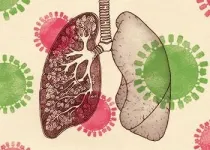Air pollution during pregnancy may affect growth of newborn babies
A study by the UPV/EHU-University of the Basque Country analyses the relationship between atmospheric pollution during pregnancy and the level of thyroxine in newborns
2021-07-02
(Press-News.org) According to studies in recent years, air pollution affects the thyroid. Thyroid hormones are essential for regulating foetal growth and metabolism, and play an important role in neurological development. Thyroxine (T4) is the main thyroid hormone that is circulating and the thyroid-stimulating hormone is TSH. At 48 hours newborn babies undergo a heel prick test in which thyroxine and TSH levels in the blood are measured. In fact, if the balance of these thyroid hormones is not right, the risk of developing serious diseases increases. That is why, "this study set out to analyse the relationship between atmospheric pollution during pregnancy and the level of thyroxine in the newborn", explained Amaia Irizar-Loibide, a researcher in the UPV/EHU's Department of Preventive Medicine and Public Health.
Nitrogen dioxide (NO2) and fine particulate matter less than 2.5 micra in diameter (PM2.5) are two of the main pollutants related to air pollution and vehicle traffic. PM2.5 particles for example are very fine and easily enter the respiratory tract. "In this work we specifically analysed the effect of maternal exposure to these fine particles and to nitrogen dioxide during pregnancy and the link existing with thyroxine levels in newborn babies. We have been monitoring on a weekly basis, as the development of the foetus varies greatly from one week to the next. So we tried to conduct the most detailed research possible in order to find out which the most sensitive weeks of pregnancy are", added the UPV/EHU researcher.
So the sample of the INMA (Environment and Childhood) project in Gipuzkoa was analysed. Data on the air pollutants PM2.5 and NO2, data on TSH and T4 levels from neonatal heels, etc. collected in the project were also used.
According to Amaia Irizar, "the results obtained in this study have revealed the direct relationship between exposure to fine particles during pregnancy and the level of thyroxine in newborns. However, we have not observed a clear link with exposure to nitrogen dioxide". These results therefore coincide with the limited previous research. "What we have seen in this work," stressed Irizar, "is that exposure during the first months of pregnancy has a direct influence on the balance of thyroid hormones. These babies tend to have a lower level of thyroxine. As the pregnancy progresses, we found that this relationship gradually diminishes, i.e. the mother's exposure gradually becomes less important. In late pregnancy, however, this link becomes apparent again, but displays an opposite effect: as the concentration of these fine particles increases, we have seen that the level of thyroid hormones also increases, which has the opposite effect on the balance". "It is not clear what mechanism lies behind all this. In any case, we have come to the conclusion that the most sensitive periods of pregnancy in terms of atmospheric pollution are the early and late months," the UPV/EHU researcher stressed.
"The next task would be to study the mechanisms by which these fine particles cause opposing effects in early and late pregnancy. In fact, these particles are nothing more than small spheres made up of carbon, and it is not clear whether the effect these spheres exert is because they pass from the placenta to the baby, whether other components attached to the particles are released once they have entered the body...," she explained. "We need to continue to investigate whether exposure during pregnancy affects not only thyroid hormones, but also other aspects such as neuropsychological development, growth, obesity, etc.," explained Amaia Irizar.
INFORMATION:
INMA - Environment and Childhood Project
INMA (Environment and Childhood) is a research project that aims to analyse early exposure to environmental pollutants and their impact on infant health.
[Attachments] See images for this press release:

ELSE PRESS RELEASES FROM THIS DATE:
2021-07-02
When the analysis of digital data reaches its limits, methods that focus on observations made by individuals can be useful. In contexts such as the coronavirus pandemic, a method called human social sensing can elicit information that is difficult to obtain from digital trace data. Prof. Frauke Kreuter at Ludwig-Maximilians-Universitaet (LMU) in Munich is now using this method with the global "Covid Trends & Impact Survey" to predict the course of the pandemic.
Despite today's researchers in the social sciences having access to historically unparalleled amounts of data, many aspects of contemporary social developments have proven difficult to predict. National elections and the ongoing coronavirus pandemic are highly visible examples ...
2021-07-02
The seasonal flu kills up to 600 000 people a year worldwide and has a century-long history of pandemics. Examples include the Spanish flu in the late 1910's or the H1N1 in 2009, which together claimed more than 50 million lives. "The way the stage is set tells us that it is not a matter of if but rather of when there will be a next pandemic. And preparing ourselves for that demands intensive fundamental research and constant accumulation of knowledge about these viruses and the diseases they cause", says Maria João Amorim, IGC principal investigator and leader of the team that conducted the study.
When a virus like influenza enters our lungs, it is quickly faced with cocktails of ...
2021-07-02
An international study has elucidated the structure of a protein that is required for the assembly and stability of photosynthetic membranes.
Plants, algae and cyanobacteria convert carbon dioxide and water into biomass and oxygen with the aid of photosynthesis. This process forms the basis of most forms of life on Earth. Global warming is exposing photosynthetic organisms to increasing levels of stress. This reduces growth rates, and in the longer term presents a threat to food supplies for human populations. An international project, in which Ludwig-Maximilians-Universitaet ...
2021-07-02
Researchers based in Munich and Tuebingen have developed an open-source camera system that images natural habitats as they appear to rodents.
During the course of evolution, animals have adapted to the particular demands of their local environments in ways that increased their chances of survival and reproduction. This is also true of diverse aspects of the sensory systems that enable species to perceive their surroundings. In the case of the visual system, these adaptations have shaped features such as the positioning of the eyes and the relative acuity of different regions of the retina.
However, our knowledge of the functional evolution of visual systems in mammals has remained relatively sparse. "In the past 10 or 15 years, the mouse has become the favored model ...
2021-07-02
Elisa Cordero, a doctor at the Virgen del Rocío University Hospital, researcher at the Institute of Biomedicine of Seville (IBiS) and professor in the Department of Medicine at the University of Seville, led a study involving researchers from 12 Spanish hospitals to study the clinical characteristics and facilitate the prognosis of solid organ transplant recipients with COVID-19.
The study provides a more precise description of the complications caused by Covid-19 in organ transplant recipients and has provided useful clinical indicators to identify the disease early. This makes it possible to determine therapeutic and care measures ...
2021-07-02
There are plenty of negatives associated with smart technology -- tech neck, texting and driving, blue light rays -- but there is also a positive: the digital age is not making us stupid, says University of Cincinnati social/behavioral expert Anthony Chemero.
"Despite the headlines, there is no scientific evidence that shows that smartphones and digital technology harm our biological cognitive abilities," says the UC professor of philosophy and psychology who recently co-authored a paper stating such in Nature Human Behaviour.
In the paper, Chemero and colleagues at the University of Toronto's Rotman School of ...
2021-07-02
A new study disputes the prevailing hypothesis on why Mercury has a big core relative to its mantle (the layer between a planet's core and crust). For decades, scientists argued that hit-and-run collisions with other bodies during the formation of our solar system blew away much of Mercury's rocky mantle and left the big, dense, metal core inside. But new research reveals that collisions are not to blame--the sun's magnetism is.
William McDonough, a professor of geology at the University of Maryland, and Takashi Yoshizaki from Tohoku University developed a model showing ...
2021-07-02
Ibaraki, Japan - The flavor of a tomato is an interaction between its taste and aroma. Now, researchers from Japan and the United States have revealed that the pigments that determine the colors of tomatoes also affect their flavor.
In a study published this month, researchers from University of Tsukuba developed a new method to rapidly measure the pigment profiles of tomatoes and used the technique to explore how pigments affect the taste and aroma of different tomato varieties.
The color of tomatoes is produced by combinations of different types of pigments, including carotenoids and chlorophylls. These pigments can also affect the accumulation of flavor-related compounds such as sugars, which affect the taste of tomatoes, and volatile ...
2021-07-02
A surprising study by UNSW on the behaviour of unrelated lizards in very different parts of the world has demonstrated how evolution can lead to different species learning the same skills.
The study in Ecology Letters documents how the Anolis lizard species in the Caribbean, and the Draco lizard species in Southeast Asia, have solved the challenge of communicating with one another to defend territories and attract mates.
It found males from both species perform elaborate head bob and push up displays, and rapidly extend and retract their often large and conspicuously coloured dewlap, or ...
2021-07-02
The muskrat, a stocky brown rodent the size of a Chihuahua - with a tail like a mouse, teeth like a beaver and an exceptional ability to bounce back from rapid die-offs - has lived for thousands of years in one of Earth's largest freshwater deltas, in northeastern Alberta, Canada.
Today, this delta lies within one of the largest swaths of protected land in North America: a national park five times the size of Yellowstone that's home to the planet's biggest herd of free-roaming bison and the last natural nesting ground for the endangered whooping crane. It's also central to the culture ...
LAST 30 PRESS RELEASES:
[Press-News.org] Air pollution during pregnancy may affect growth of newborn babies
A study by the UPV/EHU-University of the Basque Country analyses the relationship between atmospheric pollution during pregnancy and the level of thyroxine in newborns



